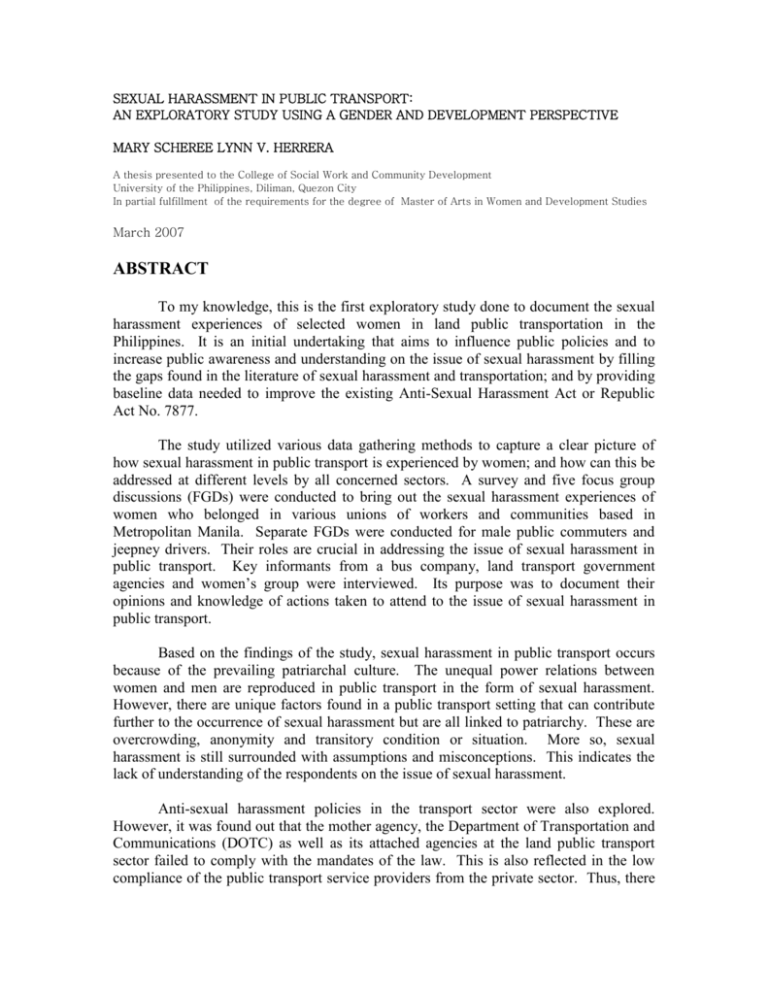The present study was an initial undertaking to fill the gaps found in
advertisement

SEXUAL HARASSMENT IN PUBLIC TRANSPORT: AN EXPLORATORY STUDY USING A GENDER AND DEVELOPMENT PERSPECTIVE MARY SCHEREE LYNN V. HERRERA A thesis presented to the College of Social Work and Community Development University of the Philippines, Diliman, Quezon City In partial fulfillment of the requirements for the degree of Master of Arts in Women and Development Studies March 2007 ABSTRACT To my knowledge, this is the first exploratory study done to document the sexual harassment experiences of selected women in land public transportation in the Philippines. It is an initial undertaking that aims to influence public policies and to increase public awareness and understanding on the issue of sexual harassment by filling the gaps found in the literature of sexual harassment and transportation; and by providing baseline data needed to improve the existing Anti-Sexual Harassment Act or Republic Act No. 7877. The study utilized various data gathering methods to capture a clear picture of how sexual harassment in public transport is experienced by women; and how can this be addressed at different levels by all concerned sectors. A survey and five focus group discussions (FGDs) were conducted to bring out the sexual harassment experiences of women who belonged in various unions of workers and communities based in Metropolitan Manila. Separate FGDs were conducted for male public commuters and jeepney drivers. Their roles are crucial in addressing the issue of sexual harassment in public transport. Key informants from a bus company, land transport government agencies and women’s group were interviewed. Its purpose was to document their opinions and knowledge of actions taken to attend to the issue of sexual harassment in public transport. Based on the findings of the study, sexual harassment in public transport occurs because of the prevailing patriarchal culture. The unequal power relations between women and men are reproduced in public transport in the form of sexual harassment. However, there are unique factors found in a public transport setting that can contribute further to the occurrence of sexual harassment but are all linked to patriarchy. These are overcrowding, anonymity and transitory condition or situation. More so, sexual harassment is still surrounded with assumptions and misconceptions. This indicates the lack of understanding of the respondents on the issue of sexual harassment. Anti-sexual harassment policies in the transport sector were also explored. However, it was found out that the mother agency, the Department of Transportation and Communications (DOTC) as well as its attached agencies at the land public transport sector failed to comply with the mandates of the law. This is also reflected in the low compliance of the public transport service providers from the private sector. Thus, there are no concrete efforts being undertaken both from the public and private transport sectors to address the issue of sexual harassment in public transport. Considering all these, the study recommends three main strategies or mechanisms that can be employed to solve not only the problem of sexual harassment in public transport but also sexual harassment in general and patriarchal culture. These are: (1) research on women; (2) policy advocacy; and (3) awareness-building. It is hoped that through these strategies, it would be able to capture what the literature on sexual harassment and transportation failed to look at; what the law excluded from its scope and coverage; and what the women’s movement left behind in its advocacy and agenda.






